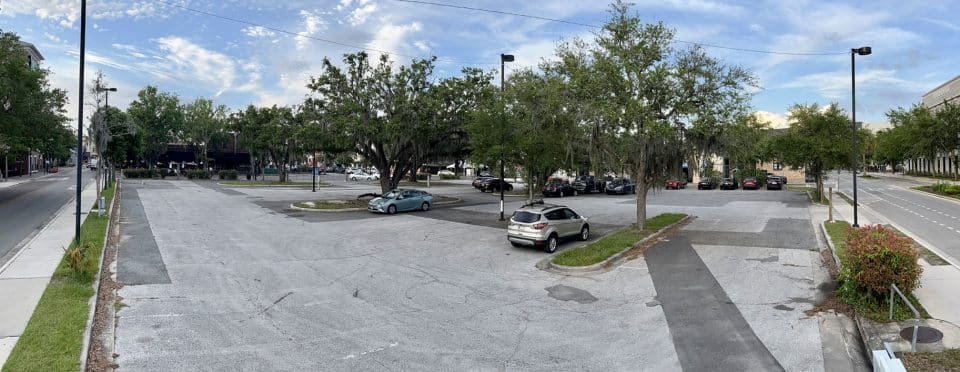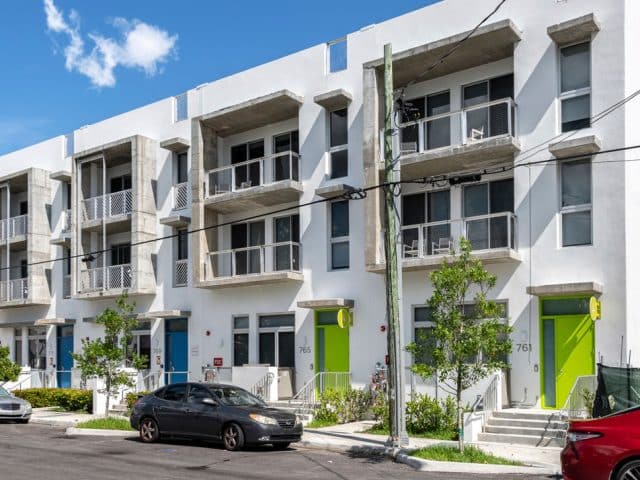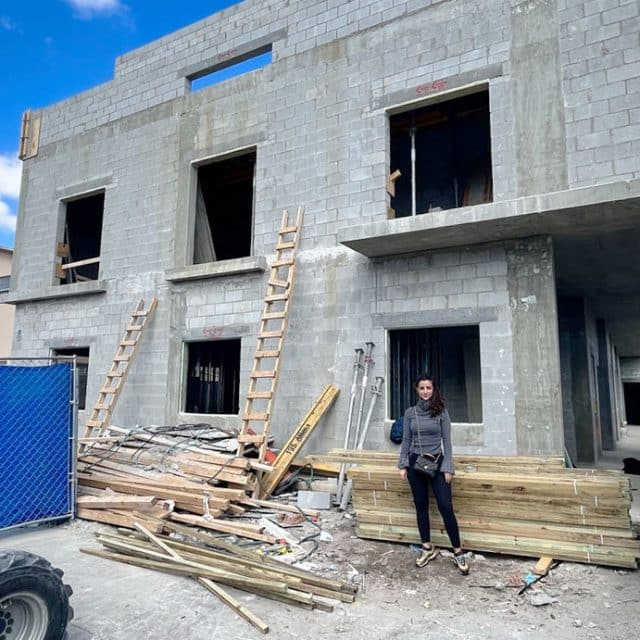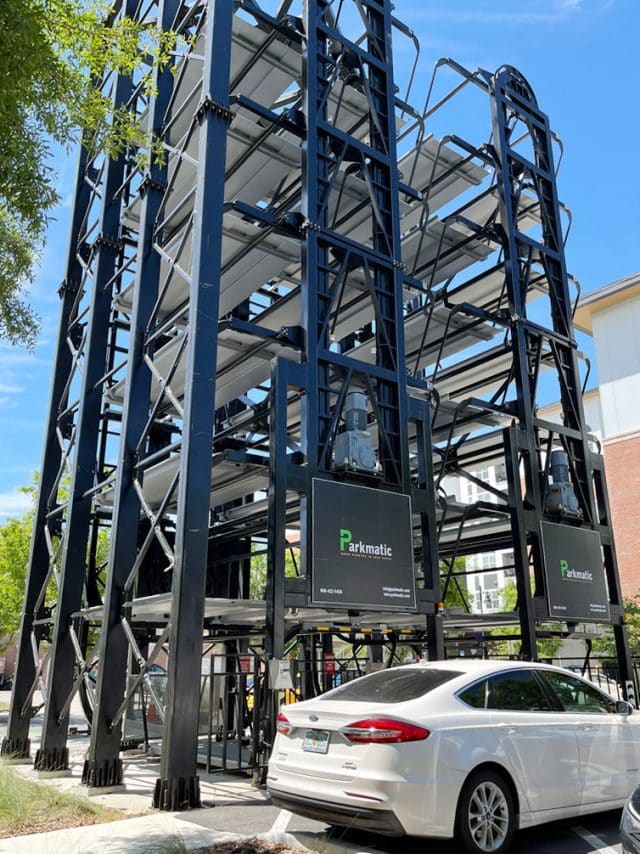
Parking Puzzle
Roughly a century ago, as car ownership boomed and the automobile reshaped America, cities discovered they had a problem. Where to park all the cars? “American cities are faced with an extreme shortage of automobile parking spaces,” bemoaned a 1952 U.S. traffic engineering study entitled “Zoning and Traffic.” Happily, the authors reported, cities had found a simple solution: Make the private sector fix the problem.
In the 1950s and 1960s, most urban and suburban communities mandated that whenever a building was constructed or expanded the owner needed to provide a minimum number of off-street spaces to store cars, according to the American Planning Association. Developers couldn’t build unless their plans included enough off-street parking to meet local regulations. It seemed sensible: Americans were moving to the suburbs and demanded a convenient place to park wherever they went; parking helped ensure efficient movement of traffic.
But in recent years academic researchers, urban planners and entrepreneurs have criticized cities’ “parking minimums” for relying on sketchy data, being subject to political whims and running counter to many local priorities. Various academic research studies have shown that excessive parking supply pushes buildings apart and reduces density, increases the cost of development, discourages alternative modes of transportation, and degrades the environment — by increasing polluted stormwater runoff, air pollution, and urban heat islands.

Now cities large and small are easing up on micro managing and giving the private sector a longer leash to decide how much parking to supply. At last count, 1,136 jurisdictions removed parking minimums in downtowns, transit corridors or citywide, according to the Parking Reform Network, a nonprofit that tracks parking policies.
Buffalo, N.Y., was the first big city to abolish all parking minimums, which advocates credit for spurring affordable housing downtown and reducing upfront development costs. Others followed suit, including Minneapolis; Hartford, Conn.; San Jose, Calif.; Portland, Ore.; Raleigh, N.C.; and Gainesville, Fla. Austin joined the parade of parking reformers on May 4 when its council directed city staff to eliminate all minimum off-street parking requirements, except for those with disabilities. Developers said removing parking minimums not only reduces costs but unlocks a wider variety of building types that they can tailor to local markets, especially in dense areas with high walkability, and bike and mass transit use. Even the National Parking Association, an industry trade group, now supports ditching parking minimums in favor of “allowing communities and developers to make market-based decisions on parking supply and demand.”
Source: Commercial Edge
The latest data shows America is building less parking, perhaps because of such changes. For example, newly built apartment buildings included an average 1.1 spaces per unit in 2022, down from a peak of 1.7 in 1998 and the lowest parking ratio since 1959, reported Yardi Matrix, which tracks data in apartments with 50 or more units in 120 markets. Parking provided at new office projects also declined. (See Figures 1 and 2.) The shift reflects the increasing urban nature of residential development versus the overwhelming suburban character of residential developments in decades past, according to a report from the National Apartment Association.
Source: Yardi Matrix
Not everyone is sold on the reforms. Critics argue cities that don’t ensure there’s enough parking hurt businesses, raise the ire of residents who complain of spillover parking in neighborhood streets, and irritate drivers who circle and abandon trips. “We can’t allow this free-for-all because there’s no parking,” Miami Commissioner Joe Carollo said during a discussion last year over parking. Miami’s City Commission voted to rollback reforms that had allowed the building of a rash of small apartment buildings without parking near transit stops.
The public debate over parking can get intense in part because allowing developers to overuse street parking smacks to some as a tragedy of the commons — the tendency of people to misuse a public resource regardless of the negative impact on others. “I have somewhat heated discussions with friends,” said Juan Castillo, a UF-educated city planner who drafted Gainesville’s ordinance to remove parking minimums citywide. “It can be somewhat emotional. It’s like if you live in America, you have a car and a right to a parking spot.”
Simply saying that off-street parking isn’t required doesn’t mean nobody will build it. Customers, tenants and lenders often demand it. “No one’s banning parking or removing parking with these new rules,” said Tony Jordan, director of the Parking Reform Network. “The question is should the government decide or is it OK to let the market take care of it?”
Build it and they will come
A breakthrough for the parking reform movement came in 2005 when the American Planning Association published “The High Cost of Free Parking,” an opus that has become a classic of planning literature despite its dry subject. It was the culmination of the work of the country’s foremost parking scholar Donald Shoup, a planning professor at UCLA who began studying the subject in the 1970s when few people listened. Shoup’s research debunked the idea that parking is everywhere essential to business and prosperity. Shoup cited research that shows cities that build more parking get more traffic. “Off-street parking requirements are fertility drugs for cars,” Shoup said during a presentation earlier this year in Seaside, Fla., where he accepted a lifetime achievement award. “Too much parking is not only costly, but we have to look at it.”

A review of off-street parking ordinances in nine Florida cities found a wide variation in requirements. For example, to build an apartment building in West Palm Beach you’ll typically need to provide at least 1.5 spaces for each efficiency apartment, 1.75 for each one-bedroom unit, and two or more spaces for each two or more bedroom, plus one space for every 10 units for guests. In Clearwater it’s simply one parking space per unit, and in Gainesville it’s none. A 2,000-square-foot restaurant in Fort Lauderdale needs at least 20 parking spaces, but in Orlando you can get by with 10.
Researchers have found that such byzantine requirements rely on questionable data — “pseudoscience,” according to Shoup — and often results in an oversupply of parking and other unintended consequences such as encouraging sprawl and increasing housing and other costs. Parking minimums rarely have a scientific basis, according to researchers, and some city officials admitted they have relied on ratios copied from other cities. Given that a parking spot typically requires 300 square feet, including access aisles, this means parking mandates for some land uses require more space for parking than the building they serve. A mandate of at least 20 parking spaces for a 2,000 square-foot restaurant means the space for parking is three times the size of the restaurant (20 x 300 = 6,000). Also consider that, while the U.S. doesn’t officially track off-street parking spaces, researchers estimate that there are likely three to seven times the number of parking spaces as the nation’s 275 million registered vehicles — roughly 1 billion of them.
Minimum off-street parking spaces required in selected cities
Number of parking spaces required by type of land use. U.S. data = estimated parking demand. Some square-foot requirements are based on gross floor area.
| Location | 10,000-square-foot office building | One-bedroom apartment | 2,000-square-foot restaurant |
|---|---|---|---|
| Clearwater | 0 | 1 | 0 |
| Fort Lauderdale | 40 | 1.75 | 20 |
| Gainesville | 0 | 0 | 0 |
| Jacksonville | 30 | 1.75 | 1 per 4 seats, plus 1 per 2 employees at peak hour |
| Orlando | 25 | 1 | 10 |
| Pensacola | 33 | 1 | 20 |
| Miami | 30 | 1.5 | 6 |
| Tampa | 33 | 1.5 | 0.25 spaces per person |
| West Palm Beach | 29 | 1.75 | 20 |
| U.S. | 33 | 1 | 30 |
U.S. variables: office building in general urban/suburban setting; per bedroom in mid-rise building, dense/urban setting not within half mile of transit; for “high-turnover (sit-down) restaurant” in a general urban/suburban setting.
Sources: UF Bergstrom Real Estate Center review of municipal and development codes; Institute of Transportation Engineers’ Parking Generation Manual, 5th Edition
If “free” parking isn’t really free, how much is it? It’s $29,000 per parking spot, based on the median U.S. cost to build a structured parking facility, according to a parking construction report from West Palm Beach-based WGI, a transportation engineering firm. This excludes soft costs such as land, design and development fees, said Rob McConnell, a principal in WGI’s parking group. A surface lot runs 80% to 85% less, roughly $5,000 a spot, he said, depending on site preparation and paving material, such as asphalt, concrete or pervious pavements. Also excluded are opportunity costs, that is revenue an owner forgoes for not putting the land to better use.
These costs are often hidden from the consumer. A 2017 academic study in the journal Housing Policy Debate found that a space in a garage adds 17% to the average monthly rent paid by an apartment dweller. Roughly 708,000 U.S. households without a car have a garage parking space, which means they collectively pay $440 million a year for parking they don’t need, according to the study.
While off-street parking minimums have gotten the most attention, and are the focus of this story, researchers and planners said it’s only one piece of a parking puzzle that communities need to address to improve the livability of neighborhoods, particularly dense urban areas that are attracting more residents. Various communities are rolling out additional reforms such as replacing parking minimums with maximums, encouraging more shared parking facilities, introducing demand-pricing for on-street parking meters and creating “parking benefit districts” to funnel parking revenue into improving streetscapes, neighborhood walkability, bike lanes and mass transit. There’s a lot riding on such reforms. According to Shoup cities that charge too much or too little for on-street parking can cause a lot of harm. He wrote: “If the price is too high and many curb spaces are vacant, adjacent businesses will lose customers, employees will lose jobs, and cities will lose tax revenue.”
As for developers, the existence of minimum off-street parking mandates can make or break a deal. Jack Shad, former director of Jacksonville’s parking department and now an urban planning consultant, said, “When I’m working with private clients the first question I ask is ‘how much parking do you think you need?’ It affects what your total development costs and the rents you need to charge to make it a feasible project. It’s a big hindrance in urban-style projects.”
Deregulating Buffalo
A good example of parking deregulation is found in western New York, where six years ago a local developer won a bid to build 201 affordably priced multifamily residences and a grocery store on an old city-owned parking lot in downtown Buffalo. Ciminelli Real Estate Corp. intended to also build a parking garage but the added expense made the project financially infeasible, said Paul Ciminelli, the company’s CEO. “We had structured parking on the site and the deal wasn’t penciling,” he said. “So, we pivoted.”

In 2017, when Buffalo removed the off-street parking mandate as part of an overhaul of its outdated 1953 zoning ordinance, Ciminelli revised his plan to exclude the parking garage. His company then had to go to court to defend against a lawsuit filed by another developer who objected to the 375 parking spaces lost. After winning the legal battle, the $76 million project opened in 2022 with 201 apartments and no parking and a 22,000-square-foot supermarket with 29 spaces. As of May 31, there was a one-year waiting list for the apartments, which rent for $693 to $1,356 a month depending on the size of the unit and a tenant’s household income. The project was partly financed with state and federal low-income housing tax credits, and the apartments are reserved for households making 80% or less than the area’s median income.
“There was really no need to have off-street parking,” said Ciminelli, who estimated most of the residents don’t own vehicles and instead rely on buses, ride-sharing services and bicycles. Those with cars can pay to park on surface lots or in garages nearby. “There are 2,400 spaces within a five-minute walk,” he said.
In a 2021 study published in the Journal of the American Planning Association, University of Buffalo researchers found the plans for 36 developments submitted to the city included an average of 21% fewer spots than they would have been required prior to the reforms. However, 19 of the projects planned the same or more parking spots required by the old parking rules. “Despite the unprecedented scope of the reform, parking lots did not vanish from development proposals,” the authors wrote. “Marketability also influences financing decisions for developments; in Buffalo, tenants traditionally expect plentiful onsite parking.”
Parking conundrum in Miami

Despite all the data and arguments over parking minimums, the issue often comes down to fairness — and politics. If a development doesn’t provide enough parking, public officials risk complaints from residents about a lack of street spots, increased traffic and cars clogging residential neighborhoods.
Miami is probably the best example of a city that has openly struggled with the issue. In 2015, its city commission abolished parking minimums for buildings less than 10,000 square feet and within walking distance of bus stops and train stations. The change was spearheaded by Andrew Frey, a planner and sometime developer who rounded up a coalition of builders and housing advocates to lobby the commission to expand parking reforms that already abolished parking requirements for residential buildings downtown.
Frey said he was motivated to recreate moderate-density housing like the brownstones he admired in cities like Boston and the charming Spanish Revival and Mediterranean-style apartments built in South Florida roughly a century ago during an era of little land use regulation and no parking requirements. But he said it was virtually impossible to construct such buildings under the city’s parking mandate, which generally requires developers provide 1.5 parking spaces for each rental unit. “It always comes back to parking if you want to build those classic multifamily homes that you see in amazing cities around the world,” said Frey, who now serves as the director of the city’s real estate department. With the parking minimums removed, developers responded by building apartments on many small lots, particularly in Little Havana, a neighborhood close to downtown. Frey built four townhouses with a total of 16 units on two lots, none with parking. Another developer taking advantage of the change was Natalie Duran, who operates Upturn Group, a development and consulting firm that teamed with partners to build several affordable multifamily residential buildings with no or limited parking.
Nevertheless, by early 2022 city commissioners grew tired of complaints of people parked in every available on-street spot and sometimes illegally in their neighborhoods. Miami’s limited bus and train service was inadequate to meet the demand for convenient transportation, contended Commissioner Manolo Reyes. “This is not a pedestrian and bicycle city. It’s still (dominated by) the automobile,” he said before voting to reinstate the parking minimums. “(Developers) get a parking reduction and people are still using their automobiles. They constantly park in front of the homes, and on the swales and it’s a mess.”

At the time “hundreds” of projects that would benefit from the parking reduction were in the pipeline, a city staffer told commissioners during a meeting. City officials declined to confirm the number or to provide data on how many buildings were constructed without parking. The new ordinance still allows developers to apply for a parking reduction, but only after first gaining a variance approval from the commission. City officials seem sensitive about the fairness of foisting parking externalities onto the driving public, which is long accustomed to ample and free or low-cost parking. Frey cast the issue in another light. “You’re putting externalities on people who don’t want or need parking,” he said. “They have to pay more for their places and it harms the walkability of their neighborhoods.”
Duran said she is now busy reworking plans for 11 affordable housing apartments her company was to build on a small lot. Unless the commission permits a variance, her group may need to build the units atop a parking podium, which could scuttle the project. “That parking is not going to be free. You just added 20% to my construction cost,” she said. “The way I see it parking is an amenity. Housing is a necessity.”
Convenient, available and free?
People’s dependency on passenger cars is a fact of life not only in Miami but virtually everywhere in auto-centric America. Several Buffalo developers and lenders told University of Buffalo researchers that “reducing car dependency would be a slow and incremental process given a lack of current infrastructure to support nonmotorized transport, and distances between origins and destinations.”
In the end, it’s clear there’s little neutral ground when it comes to the complex and interconnected world of parking. “I think that we don’t understand lots of aspects of parking that are critical to reducing its supply,” said Ruth Steiner, an associate professor in the University of Florida’s Department of Urban Regional Planning who completed a study on parking policies in Ft. Lauderdale and Miami. “At the same time, some places do not have enough parking, which can be a challenge to manage.”
The fact is, as any driver will tell you, at certain times and locations parking spots are nonexistent. On a recent Saturday evening drive through historic downtown St. Augustine, every on-street space was filled, block after block. Private lots with homemade signs advertising $20 spots were full and lines of cars backed up outside a 1,200-space municipal parking garage despite three red “Xs” on electronic signs above the entrances, denoting no spaces available. After about a half hour of circling, the driver and three passengers drove to a restaurant in an adjacent city.
“There’s a maxim among people who deal with parking professionally that helps explain this situation: everyone wants parking to be convenient, available and free,” journalist Henry Grabar wrote in his recently published book, “Paved Paradise: How Parking Explains the World,” about the history and modern-day challenges of parking. “But the forces of time, space and money conspire in such a way that no thriving place can meet more than two of the three parking needs.”
Braking for parking in Gainesville id="supplement"

Last November, city commissioners reformed Gainesville’s off-street parking requirements largely by swapping a single word in its zoning ordinance. By simply replacing “minimum” with “maximum” in a table of parking ratios for dozens of land uses, city officials slammed on a proverbial parking brake: It means developers no longer must provide off-street parking spots.
City officials cautioned Gainesville isn’t doing away with parking — which is an impossibility given that the market absolutely demands it. Instead, the new regs allow the city to focus on ensuring builders don’t provide too much parking. “We’re opening the way for developers to provide what the market needs but not excessive parking,” said Juan Castillo, a city planner. For example, with the switcheroo a multifamily building can now provide a maximum of one parking space per bedroom, which previously was the minimum number of spaces required. Similarly, an office building now may provide no more than one space per 300 square feet of gross floor area, a barber can’t provide more than two parking spaces per chair, a golf course no more than six spaces per hole and a movie theater no more than one space per two seats. Developers can petition for more spaces if there is sufficient demand. Conversely, a developer can take the risk of providing no spaces if she believes the market will support it.
Gainesville Mayor Harvey Ward said building too much parking not only degrades the environment but it’s wasteful. “Land is a finite resource and if we use enormous quantities of it to require parking — primarily asphalt surface parking — that’s land that doesn’t get used as a place for people to live. It doesn’t get used for commerce. It doesn’t get used for parks or for any of the things that we like to do,” he said.
Gainesville, like most cities, regulates parking in many ways. In addition to managing municipal parking facilities and on-street parking meters, it charges residents $216 a year for a street parking permit in some neighborhoods, requires structured parking for any development with more than 200 spaces, and dictates developers provide bicycle, motorcycle and scooter parking for many land uses.
Gainesville businesses employ various strategies to satisfy parkers in areas with particularly high demand, most notably near the University of Florida’s main campus and downtown, areas where the city relaxed parking minimums years ago to promote density and walkability. These include sharing parking lots, arranging for parking on nearby vacant land and unbundling rents from parking spaces.
John Fleming, managing partner with Trimark Properties, unbundles the rent of livable space from parking spots at student-oriented apartment buildings the company operates near UF. This means tenants who don’t need parking don’t subsidize those who do. A tenant wanting car storage pays an additional $50 to $200 a month depending if their space is on site or in a lot a block or two away. Trimark has buildings with 603 units and 1,268 rooms but just 470 parking spots. About 4.5% to 6.5% of Trimark’s revenues come from such parking fees, he said.
Across the street from UF’s main campus, a retail business is rolling out another strategy: an automated parking carousel. Trulieve Cannabis Corp., reportedly Florida’s largest medicinal marijuana dispensary, installed the vending-machinelike parking system near its retail outlet to accommodate customers’ vehicles. The carousel’s manufacturer touts its equipment as stacking 16 cars in a two-space parking footprint. “That’s our biggest complaint,” store general manager Patrick Nolan said of parking. “We’re a business that needs more parking.” The device is not yet in operation, however. Trulieve is waiting for approval from the city, he said.
